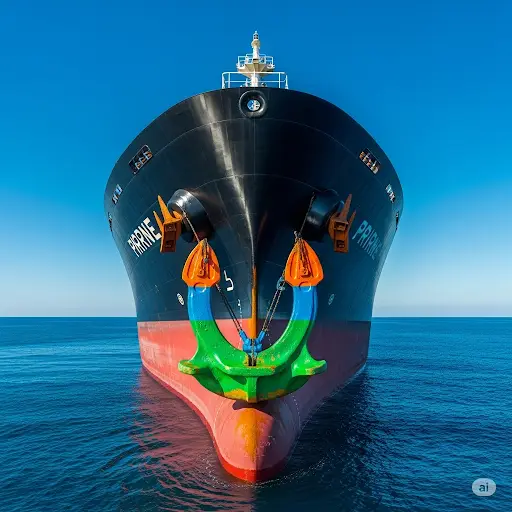The Red Sea’s New Battlefront: Direct Strikes and Supply Chain Fracture Force Oil’s Enduring Price Floor
The global oil market awakens this Monday, July 21st, not to the usual hum of supply-demand dynamics, but to the echoes of direct conflict. What began as an intermittent campaign of maritime terror in the Red Sea has now escalated, moving from the choppy waters of engagement to direct strikes on land. This weekend’s dramatic shift in military strategy has fundamentally altered the risk calculus, embedding the cost of geopolitical instability even deeper into the price of every barrel. The unseen hand we spoke of last week is now a direct, visible force, fracturing global supply lines and forcing a new reality upon energy markets.
As of this Monday afternoon in New York, crude prices are reflecting a persistent, if slightly cautious, resilience. Brent Crude is trading around $69.23/bbl, while WTI Crude is at $67.42/bbl. These figures, while not sharply higher than Friday’s close, underscore the market’s inability to significantly decline despite broader concerns about global economic growth and consistent OPEC+ supply.
The Escalation: From Sea to Shore
The most significant development over the weekend, underscoring the escalating nature of the Red Sea conflict, is Israel’s confirmation of strikes on Yemen’s Houthi-held port city of Hodeidah today. The Israeli military stated these strikes targeted infrastructure used by the Houthi movement for military purposes, including rebuilding facilities, fuel containers, and naval components allegedly involved in attacks on shipping. This marks a direct and significant escalation in military action, moving beyond defensive engagements to targeting Houthi capabilities on Yemeni soil. Defence Minister Israel Katz explicitly warned that “Yemen’s fate will be the same as Tehran’s,” linking the action to Israel’s recent heavy strikes against Iran and suggesting an even broader, more aggressive posture.
This military escalation comes on the heels of continued Houthi attacks and the palpable impact on global shipping. The past weeks have seen confirmed sinkings of commercial vessels like the MV Magic Seas and MV Eternity C, tragically resulting in casualties and significant environmental damage from oil slicks. The persistence of these attacks, combined with the Houthis’ apparent ability to regenerate capabilities, has solidified the perception of a long-term, active threat.
Oil’s Unshakeable Price Floor
The market’s current price posture is a testament to the overriding power of this geopolitical premium. In a “normal” environment, a consistent OPEC+ supply increase (the 548,000 bpd for August is still in play) coupled with last week’s mixed EIA data – particularly the large builds in U.S. gasoline (3.4 million barrels) and distillate (4.2 million barrels) inventories – would typically exert significant downward pressure on crude.
However, crude prices have largely held their ground. This resilience highlights that the Red Sea crisis is no longer a temporary “risk premium” but a structural component of oil pricing. The EIA’s own upward revision of its 2025 Brent price forecast to $68.89/bbl, explicitly due to “increased geopolitical risk,” reinforces this view, demonstrating that even official outlooks now embed this cost as a permanent fixture.
Supply Chain Fragmentation: A New Reality
The Red Sea escalation is not just about direct attacks; it’s about the accelerated fragmentation of global supply chains. The increasing number of vessels, including critical energy flows such as Greek-managed tankers carrying Russian oil, explicitly diverting around the Cape of Good Hope, is a stark manifestation of this shift. This is not merely an inconvenience; it represents a fundamental rerouting of vital maritime arteries.
The consequences are direct and tangible:
- Increased Transit Times: Adding weeks to voyages, disrupting delivery schedules and product availability.
- Massive Fuel Consumption: The longer Cape route requires significantly more fuel, adding to operational costs and the carbon footprint.
- Exorbitant Insurance Premiums: Marine war-risk insurance for Red Sea transits remains exorbitantly high, reportedly between 0.7% and 1.0% of a vessel’s value per voyage. This cost, amounting to hundreds of thousands or even millions of dollars per trip, is directly absorbed by consumers through inflated commodity prices.
This fragmentation extends beyond oil, impacting a vast array of global trade and contributing to wider inflationary pressures, testing the very resilience of just-in-time logistics models.
The Geopolitical Chessboard Deepens
The direct strikes on Yemen intertwine with the broader, volatile regional conflicts, particularly the conflict in Gaza and the ongoing civil war in Yemen. This creates an even more unpredictable environment where any escalation carries significant risks of drawing in more regional actors.
The effectiveness of current international naval operations, such as Operation Prosperity Guardian and the EU’s Aspides mission, now faces heightened scrutiny in light of this military escalation. If direct strikes on Houthi infrastructure fail to deter attacks, questions will arise about the adequacy of the international response and the diplomatic ramifications of unilateral military actions.
Demand Outlook: Headwinds Amidst Conflict
While geopolitical factors dominate, underlying demand concerns persist. General reports from various economic bodies continue to signal a modest global economic slowdown in 2025, which could temper overall oil demand growth. The Red Sea crisis itself, by contributing to global inflation and supply chain bottlenecks, could inadvertently dampen consumer spending and industrial activity, creating a complex balancing act for the market.
Strategic Implications for the Future
This escalation signals a strong likelihood that the “cost of chaos” will remain a permanent, perhaps even growing, feature of oil pricing for the foreseeable future. This will invariably impact long-term investment decisions in energy infrastructure, both upstream (extraction) and downstream (refining and distribution), and could spur renewed interest in strategic oil stockpiling by nations. The search for genuinely secure alternative shipping routes and disruptive technologies to bypass chokepoints may also gain renewed urgency.
Conclusion: The New Baseline of Risk
As Monday’s intelligence brief concludes, the message is stark: the Red Sea crisis has transformed, demanding a deeper understanding of its pervasive impact. It is no longer merely a chokepoint but a battlefront whose direct escalation is solidifying a new, higher baseline for oil prices by actively fracturing supply chains and imposing tangible, non-negotiable costs. The global energy market is now operating on a new baseline of risk, where the price of oil is inextricably linked to the escalating realities of geopolitical instability. Stay sharp, operatives; the strategic landscape demands unwavering vigilance.
Important Note on Volatility: The oil and gas market is experiencing significant volatility. Prices for crude oil, refined products, and associated logistical costs are changing rapidly. The figures quoted above reflect the general market situation as of Monday, July 21, 2025, New York Time. This is a fast-evolving situation, and continuous vigilance and reassessment are paramount.





